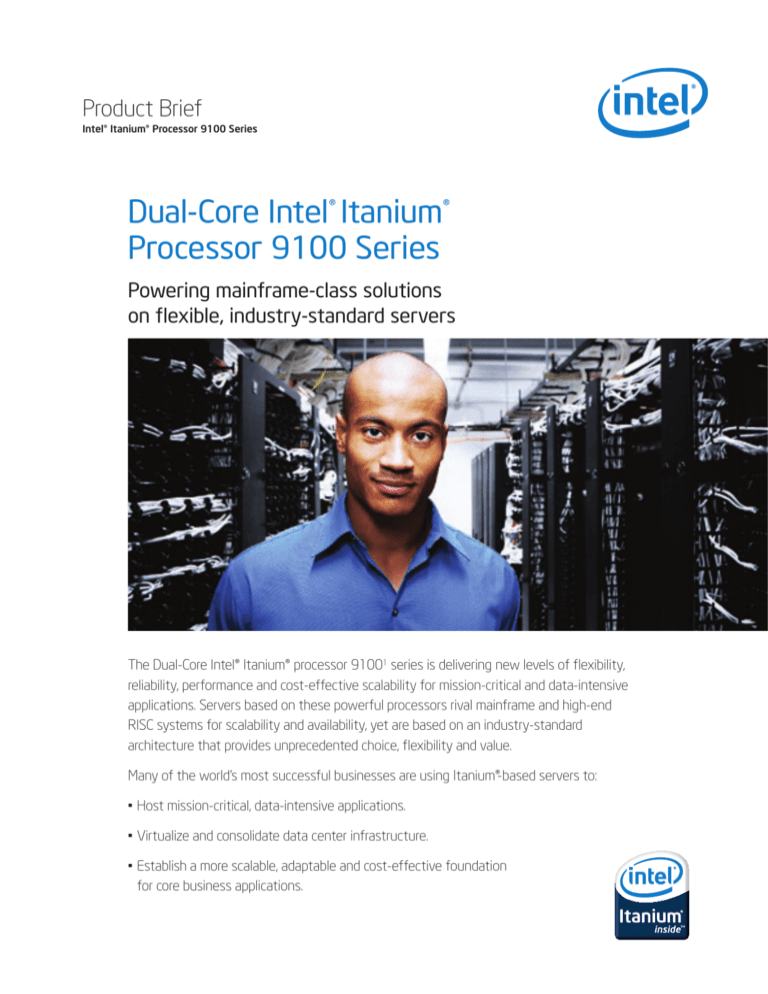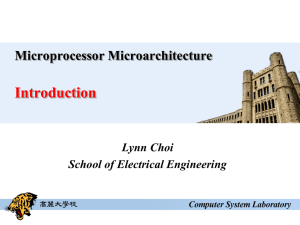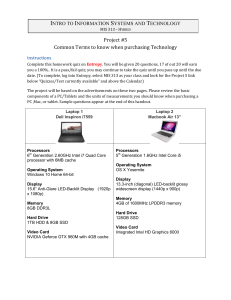
Product Brief
Intel® Itanium® Processor 9100 Series
Dual-Core Intel® Itanium®
Processor 9100 Series
Powering mainframe-class solutions
on flexible, industry-standard servers
The Dual-Core Intel® Itanium® processor 91001 series is delivering new levels of flexibility,
reliability, performance and cost-effective scalability for mission-critical and data-intensive
applications. Servers based on these powerful processors rival mainframe and high-end
RISC systems for scalability and availability, yet are based on an industry-standard
architecture that provides unprecedented choice, flexibility and value.
Many of the world’s most successful businesses are using Itanium®-based servers to:
• Host mission-critical, data-intensive applications.
• Virtualize and consolidate data center infrastructure.
• Establish a more scalable, adaptable and cost-effective foundation
for core business applications.
Built for the Data Center
Deploy your most data-intensive, mission-critical
applications with confidence
Mainframe-class systems based on the Dual-Core Intel® Itanium® processor are available
from many of today’s most respected server vendors. These large, scalable and highly
available servers provide robust support for today’s most demanding business applications,
and for HPC applications that scale best on large, shared-memory systems.
2
Optimized for:
Recommended Processora
Software Application Examplesb
Database
Dual-Core Intel® Itanium®
processor 91501
Oracle Database* (for HP-UX* and
Linux*), Microsoft SQL Server,* IBM
DB2,* MySQL Database Server*
Business
Intelligence
Dual-Core Intel® Itanium
processor 9150
SAS,* Microsoft Analysis Services,*
Hyperion SQR,* Informatica
PowerConnect*
ERP, CRM
Dual-Core Intel® Itanium
processor 9150
SAP R/3 Enterprise,* mySAP CRM*
High-performance
Computing (HPC)
Dual-Core Intel® Itanium®
processor 9130M1 (or 9110N1)
Custom applications, Ansys,*
MSC Software,* Fluent*
a
F or the very highest levels of processing and data integrity, selected Dual-Core Intel Itanium processor 9100 series
products support Core-Level Lockstep.
b
any more applications are available in each category. For a complete listing, see the Itanium Solutions Catalog.
M
whww.itaniumsolutionsalliance.org/programs/solutions_catalog.
Breakthrough Flexibility
for Growing Your Business
The hardware and software support
you need is here today
Dual-Core Intel Itanium processor-based systems:
• Are available from dozens of leading server vendors, in
configurations ranging from 2-way servers and blades, to highly
scalable systems with up to 512 processors and 128 terabytes
of globally shared memory.
• Support more than 10 operating systems, including Microsoft
Windows Server*; Linux* from Novell, Red Hat, Red Flag and
other distributors; HP NonStop*; OpenVMS*; HP-UX*; Bull
GCOS 8*; NEC ACOS-4*; IBM z/OS*; Solaris*/SPARC*, and more.
• Support more than 12,000 applications from over 2,000
software vendors, including Microsoft, BEA, IBM, Ansys,
Gaussian, Symantec/Veritas, Oracle, SAP, SAS and many others.
This broad choice of vendors, hardware and software is freeing
businesses from the restrictions of proprietary RISC and mainframe
architectures, so they have better control over their costs, risks and
solutions. It is also providing a broad community of support, and a
better foundation for rapid, ongoing innovation.
3
Proven Performance and Value for
Demanding Business and Technical Workloads
The latest Dual-Core Intel Itanium processor boosts performance yet again for Itanium-based
servers, which deliver excellent performance and value for today’s data-intensive business and
technical applications, and scales to support massive workloads.
19% Performance Gain for STAR-CD*
Performance (higher is better)
Itanium® 2 processor 9050
(1.60 GHz, 533 MHz FSB, 24 MB cache)
1.00
Itanium® 2 processor 9050
(1.60 GHz, 533 MHz FSB, 24 MB cache)
Itanium® processor 9150
1.00GHz, 667 MHz FSB, 24 MB cache)
(1.67
1.19
Itanium® processor 9150
(1.67 GHz, 667 MHz FSB, 24 MB cache)
1.19
0.0
0.2
0.4
0.6
0.8
1.0
1.2
1.4
1.0
1.2
1.4
Relative Ratio
0.0
0.2
0.4
0.6
0.8
Relative Ratio
11% Performance Gain for SPECfp*_rate_base2006
Performance (higher is better)
Itanium® 2 processor 9050
(1.60 GHz, 533 MHz FSB, 24 MB cache)
1.00
Itanium® 2 processor 9050
(1.60 GHz, 533 MHz FSB, 24 MB cache)
Itanium® processor 9150
1.00GHz, 667 MHz FSB, 24 MB cache)
(1.67
1.11
Itanium® processor 9150
(1.67 GHz, 667 MHz FSB, 24 MB cache)
1.11
0.0
0.2
0.4
0.6
0.8
1.0
1.2
1.4
1.0
1.2
1.4
Relative Ratio (estimated)
0.0
0.2
0.4
0.6
0.8
Relative
Ratio (estimated)
Benchmark Configuration Details as of July
2007 – STAR-CD*
v3.26 “A Class” workload:
• Dual-Core Itanium® 2 processor 9100 Series based Platforms: Intel® S6E5100 SDP Hitachi Cold Fusion*-3e, Chipset Hitachi ColdFusion3e,
FSB at 533/667 MT/s, 4x Intel® Itanium® processor 9150 (Montvale 1.67 GHz, FSB at 667 MHz, 24M L3 cache, A1 Stepping), 16x1 GB
DDR2-667 (ELPIDA* EBE10RD4AGFA-6E-E ), O/S Red Hat Enterprise Linux* AS release 4 (Nahant Update 4), Linux kernel version
2.6.9-42.ELsmp on IA-64, SoEMT disabled.
• Dual-Core Itanium® 2 processor 9000 Series based Platforms: Intel® S6E5100 SDP Hitachi Cold Fusion*-3e, Chipset Hitachi ColdFusion3e,
FSB at 533/667 MT/s, 4x Intel® Itanium® 2 processor 9040 (Montecito 1.6 GHz, FSB at 533 MHz, 18M L3 cache), 16x1 GB DDR2-667
(ELPIDA* EBE10RD4AGFA-6E-E ), O/S Red Hat Enterprise Linux* AS release 4 (Nahant Update 4), Linux kernel version 2.6.9-42.ELsmp
on IA-64, SoEMT disabled.
SPECfp*_rate_base2006 Configuration Details:
• Dual-Core Itanium® 2 processor 9100 Series based Platforms: Hitachi S6E4512* 4S/4U with 4x Intel® Itanium® processor 9150 (Montvale 1.67 GHz,
FSB at 667 MHz, 24M L3 cache, A1 Stepping), Memory 16 GB (16x1 GB DDR2-667 running at 667 MHz), SOEMT Disabled, O/S RedHat Enterprise
Linux* 4.0 Update-3 (2.6.9-36.EL Kernel).
• Dual-Core Itanium® 2 processor 9000 Series based Platforms: Hitachi S6E4512* with Dual-Core Intel® Itanium®2 processor 9000 series
(Montecito) 1.6 GHz, Caches on per core base: 12 MB Unified L3, 1 MB L2I, 256 KB L2D, 16 KB L1I and 16 KB L1D. C1 stepping. 533 MHz
bus, Memory 16 GB (16x1 GB DDR2-667 running at 533 MHz, SOEMT Disabled, O/S RedHat Enterprise Linux* 4.0 Update-3 (2.6.9-36.EL Kernel).
4
A Better Foundation for Enterprise Applications
The capabilities you need for your applications, your data center and your business
Scalable performance for your most
complex, data-intensive workloads
Advanced security capabilities
to protect your business
With two high-performance cores per processor, memory address-
Intel® Itanium® microarchitecture was designed with security as
ability up to 1,024 terabytes, exceptionally large on-die cache (24
a core requirement. It includes a number of features that can be
MB), and a fast new 667 MHz front-side bus, today’s Dual-Core
used to provide transformative levels of system and application
Intel Itanium processors deliver enormous compute power for
security, including:
data-intensive applications.
They also provide excellent per-core performance through multithreading (two threads per core) and Explicitly Parallel Instruction
Computing (EPIC). EPIC was designed specifically to enable massively parallel throughput, with up to six instructions per clock cycle,
enormous execution resources (128 general-purpose registers,
128 floating point registers and 8 branch registers) and a variety
of advanced capabilities for optimizing parallel throughput.
High availability for your
mission-critical applications
Itanium-based servers deliver mainframe-class reliability, availability
and serviceability (RAS) without the mainframe price tag. They
provide advanced error detection, correction and containment
across all major data pathways and the cache subsystem, and
they support integrated, standards-based error handling across
the hardware, firmware and operating system. Multiple vendors
with extensive mainframe experience have built on this foundation
to deliver fault-tolerant systems designed for uninterrupted operation. With new Core-Level Lockstep, one core can even be used to
mirror the operations of another, to enable even higher levels of pro-
• Hardware authentication of firmware, to ensure the integrity
and security of the system when first booted.
• Unique memory compartmentalization, which can be used
to prevent the insertion of foreign code into a running system.
• Fast data encryption, to enable strong security at all levels,
without excessive overhead that can drive down performance.
Lower total costs to free up
resources for innovation
Total costs tend to be considerably lower for Itanium®-based solutions than for comparable RISC and mainframe solutions, and those
cost benefits typically extend across the entire solution, including
hardware, software and services. Itanium-based solutions also help
to reduce vendor lock-in, so you retain more control and can manage your costs more effectively. These cost benefits are increased
by the outstanding energy efficiency of Dual-Core Intel Itanium
processors. They use only 104 W at peak utilization, and new
Demand Based Switching works with enabled operating systems
to reduce energy consumption even more as workloads vary.
cessing and data integrity for the most demanding environments2.
Flexible virtualization and consolidation to
simplify your data center and drive down costs
Dual-Core Intel Itanium processors include built-in, silicon-level
support for virtualization via Intel® Virtualization Technology3
(Intel® VT), and multiple hardware and software vendors are delivering advanced platform-level virtualization solutions. From physical
and logical partitioning, to OS virtualization and advanced workload
management tools, Itanium-based servers offer a wide range of
options. Combined with their scalability, availability and multi-OS
support, this makes them ideal for consolidating mission-critical
applications and streamlining data center operations.
5
A Roadmap to Increasing Value
Three more Intel Itanium processor generations are on the way
Intel is investing strongly in Itanium-based solutions, and future
• Many-core Intel Itanium processor (code-name Poulson).
Intel Itanium processor generations will deliver ongoing advances
This processor will take performance and flexibility to new
in performance, reliability, flexibility and value.
heights, with an ultra-parallel architecture built on Intel’s 32
nanometer process technology. (This new technology will
• Quad-Core Intel Itanium processor (code-name Tukwila). This
support roughly 4 times the transistor density of Tukwila.)
processor will be equipped with more than two billion transistors
and can be expected to deliver more than double the performance
• And Beyond. This future Intel Itanium processor (code-name
of today’s Intel Itanium processors (based on system performance
Kittson) is in definition today and will deliver another major leap
benchmark projections). It will also include the Intel® QuickPath
in performance and value.
Architecture, a new system architecture that will help increase the
performance of future generations of multi-core Intel Itanium (and
Intel® Xeon®) processors. Tukwila processor shipments will ramp in
2009, and systems for IT evaluation and software certifications
(seed units) will be available in the first part of the year.
Intel also works continuously with the broader community, including the Itanium Solutions Alliance, whose founding members have
committed to a $10 billion investment in Itanium-based solutions
through 2010. Those investments will continue to fuel ongoing
advances that will help to position your business for faster, more
cost-effective growth.
Dual-Core Intel® Itanium® Processor 9100 Seriesa
Processor Number1
Speed/L3
Cache Size
Front-Side
Bus Speed
Total
Dissipated
Power
Hyper-Threading
Technology4
Demand
Based
Switching
Intel®
Cache Safe
Technology
Intel®
Virtualization
Technology
Dual-Core Intel® Itanium®
processor 9150M
1.66 GHz/
24 MB
667 MHz
104 W
yes
yes
yes
yes
Dual-Core Intel® Itanium®
processor 9150N
1.60 GHz/
24 MB
400/533
MHz
104 W
yes
yes
yes
yes
Dual-Core Intel® Itanium®
processor 9140M
1.66 GHz/
18 MB
667 MHz
104 W
yes
yes
yes
yes
Dual-Core Intel® Itanium®
processor 9140N
1.60 GHz/
18 MB
400/533
MHz
104 W
yes
yes
yes
yes
Dual-Core Intel® Itanium®
processor 9120N
1.42 GHz/
12 MB
400/533
MHz
104 W
yes
no
yes
yes
Dual-Core Intel® Itanium®
Processor 9130M
1.66 GHz/
8 MB
667 MHz
104 W
no
no
yes
yes
Intel® Itanium® Processor
9110N (single core)
1.60 GHz/
12 MB
400/533
MHz
75 W
no
no
yes
yes
a
Core-Level Lockstep is supported in selected Dual-Core Intel Itanium processor 9100 series products (at 400/533 front-side bus speeds).
6
Quick Guide to Features and Benefits
Business Advantages
Features/Function
Benefits
Mainframe-class reliability
for uninterrupted business
operations
Enhanced Machine Check Architecture: Defines
standards-based interfaces for integrated error
handling across hardware, firmware and OS
Provides outstanding availability for maximum
uptime, and enables system and software vendors to
collaborate effectively on next-generation solutions
Socket-Level Lockstep: Enables a processor in one
socket to mirror the operations of another
Can be used to provide even higher processing and
data integrity for the most mission-critical applications
Core-Level Lockstep: Enables one processor core to
mirror the operations of the other
Scalable, flexible systems
for virtualizing and
consolidating your data center
High-end computing power
for fast handling of complex
transactions, massive amounts
of data and large user
populations
Intel® Cache Safe Technology: Automatically disables
affected cache lines in the event of a cache error
Allows processor and server to safeguard against
errors that could bring down other platforms
Advanced error detection/correction/containment
across all major data pathways (includes ECC memory
with mirroring and memory device failure correction
capabilities)
Servers can detect, log, correct and otherwise respond
to errors to increase uptime
Advanced system-level features, such as hotplug power supplies and disks, built-in hardware
redundancy, and enhanced manageability
Servers are highly reliable, manageable and easily
serviced to provide maximum uptime for businesscritical applications
Wide range of configurations: From 2-processor
servers and blades, to systems with up to
512 processors
Scales to support the most demanding applications
and workloads
Powerful clustering: Up to 10,000+ processors
per cluster
Massive scalability for HPC applications
Silicon-level virtualization support:
Intel® Virtualization Technology
Better workload isolation and less overhead when
consolidating applications in virtualized environments
Dual-Core processor
Doubles the execution resources per processor
Large addressable memory: Up to 1,024 terabytes
Able to hold vast datasets in main memory for
faster processing
Low-latency 24 MB on-die L3 cache: (14 cycles)
providing 102 GB/s aggregate bandwidth to the cores2
Fast access to data and improved throughput
for memory-intensive applications
2.5 MB L2 (5-7 cycles) and single-cycle latency L1
High-bandwidth 667 MHz System Bus
1.66 GHz frequency, with up to 6 instructions
per clock cycle
Fast responses to complex calculations
High-precision floating-point architecture
Intel volume economics for
lower costs and better value
Less costly than proprietary RISC and mainframe
offerings
Better value, more choice and stronger investment
protection than competing solutions
Strong Intel® Itanium® processor family roadmap
Broad hardware, software (OS and application)
and vendor support
Energy efficiency for
reducing data center costs
Dual-core at 104 W
New Demand-Based Switching dynamically reduces
energy consumption during typical CPU utilization
(in conjunction with enabled OS)
Improved data center density with lower power
and cooling costs
7
www.intel.com/itanium
Contacts
United States and Canada
Intel Corporation
Robert Noyce Building
2200 Mission College Blvd
P.O Box 58119
Santa Clara, CA 95052-8119
USA
Europe
Intel Corporation (UK) Ltd.
Pipers Way
Swindon
Wiltshire SN3 1RJ
Japan
Intel Japan (Tsukuba HQ)
5-6
Tokodai Tsukuba-shi
300-2635 Ibaraki-ken
Japan
South America
Intel Semiconductores do Brasil LTDA
Av. Dr. Chucri Zaidan, 940-10° andar
04583-904 São Paulo, SP
Brazil
Asia-Pacific
Intel Semiconductor Ltd.
32/F Two Pacific Place
88 Queensway, Central
Honk Kong, SAR
Intel processor numbers are not a measure of performance. Processor numbers differentiate features within each processor family, not across different processor families.
See http://www.intel.com/products/processor_number for details.
Check with your vendor for information regarding support for Lockstep technologies.
3
Intel® Virtualization Technology requires a computer system with an enabled Intel® processor, BIOS, virtual machine monitor (VMM) and, for some uses, certain platform software enabled for it. Functionality, performance
or other benefits will vary depending on hardware and software configurations and may require a BIOS update. Software applications may not be compatible with all operating systems. Please check with your application
vendor.
4
Hyper-Threading Technology requires a computer system with an Intel® processor supporting HT Technology and a HT Technology enabled chipset, BIOS and operating system. Performance will vary depending on the
specific hardware and software you use. See http://developer.intel.com/products/ht/Hyperthreading_more.htm for additional information.
Performance tests and ratings are measured using specific computer systems and/or components and reflect the approximate performance of Intel products as measured by those tests. Any difference in system
hardware or software design or configuration may affect actual performance.
INFORMATION IN THIS DOCUMENT IS PROVIDED IN CONNECTION WITH INTEL® PRODUCTS. NO LICENSE, EXPRESS OR IMPLIED, BY ESTOPPEL OR OTHERWISE, TO ANY INTELLECTUAL PROPERTY
RIGHTS IS GRANTED BY THIS DOCUMENT. EXCEPT AS PROVIDED IN INTEL'S TERMS AND CONDITIONS OF SALE FOR SUCH PRODUCTS, INTEL ASSUMES NO LIABILITY WHATSOEVER, AND INTEL
DISCLAIMS ANY EXPRESS OR IMPLIED WARRANTY, RELATING TO SALE AND/OR USE OF INTEL PRODUCTS INCLUDING LIABILITY OR WARRANTIES RELATING TO FITNESS FOR A PARTICULAR PURPOSE,
MERCHANTABILITY, OR INFRINGEMENT OF ANY PATENT, COPYRIGHT OR OTHER INTELLECTUAL PROPERTY RIGHT. UNLESS OTHERWISE AGREED IN WRITING BY INTEL, THE INTEL PRODUCTS ARE
NOT DESIGNED NOR INTENDED FOR ANY APPLICATION IN WHICH THE FAILURE OF THE INTEL PRODUCT COULD CREATE A SITUATION WHERE PERSONAL INJURY OR DEATH MAY OCCUR.
Intel may make changes to specifications and product descriptions at any time, without notice. Designers must not rely on the absence or characteristics of any features or instructions marked "reserved" or "undefined."
Intel reserves these for future definition and shall have no responsibility whatsoever for conflicts or incompatibilities arising from future changes to them. The information here is subject to change without notice. Do
not finalize a design with this information. The products described in this document may contain design defects or errors known as errata which may cause the product to deviate from published specifications. Current
characterized errata are available on request. Contact your local Intel sales office or your distributor to obtain the latest specifications and before placing your product order.
Copies of documents which have an order number and are referenced in this document, or other Intel literature, may be obtained by calling 1-800-548-4725, or by
visiting www.intel.com.
*Other names and brands may be claimed as the property of others.
Copyright © 2008 Intel Corporation. All rights reserved. Intel, the Intel logo, Itanium, and Intel Xeon are trademarks of Intel Corporation in the U.S.
and other countries.
Please Recycle 318691-002US
Printed in USA
1208/RS/OCG/XX/PDF 1
2








